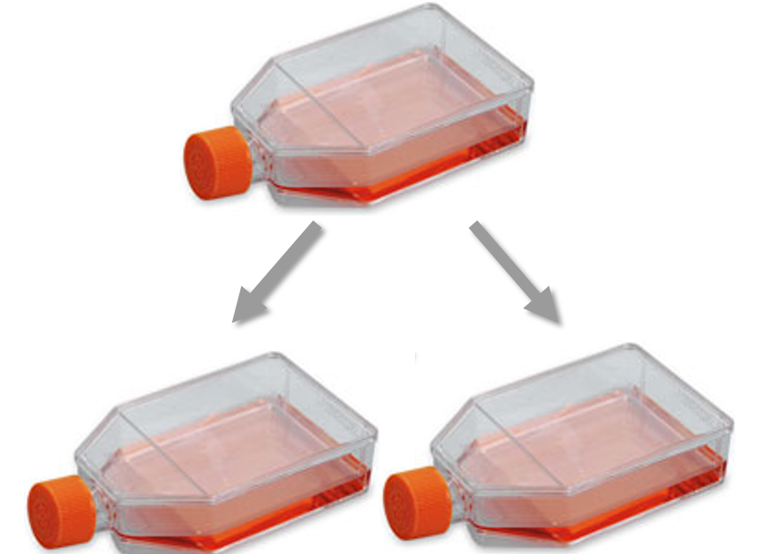HuH-7 Cells should be cultured in DMEM supplemented with 10% FBS. Cells should be grown at 37 °C in a 5% CO2 setting.
Subculture Protocol for HuH-7

To subculture:
Renew medium 2-3 times a week, or as needed according to media pH, and maintain cell confluency between 30-90%. Do not allow cell concentration to exceed 90% confluency, otherwise cells will decrease proliferation rates. The doubling time of HuH-7 cells is 24 hours.
Cells can also be subcultured by centrifuging and resuspending in fresh medium:
- Rinse cells with trypsin-EDTA to remove media containing FBS.
- Add just enough trypsin-EDTA to cover the bottom of the flask and observe for cell detachment under a microscope. Detachment should occur within 2-15 minutes. Do not agitate cells during this process in order to avoid clustering of cells. If cells do not detach, place flask in incubator for to facilitate dispersal.
- Neutralize trypsin-EDTA by adding media containing FBS at 4x the volume of trypsin-EDTA added; centrifuge the cells and remove the supernatant.
- Add 10 mL of growth medium to the pellet and aspirate with gentle pipetting to resuspend cells.
- Split cells: Add an aliquot of the cell suspension to a new culture vessel at the appropriate split ratio.
- Return flask to 37°C with 5% CO2.
To cryopreserve HuH-7 cells
After cell collection, the cells can be frozen in growth medium supplemented with 10% (v/v) DMSO following slow freeze methods. Long term storage of HuH-7 cells includes storage in the liquid nitrogen vapor phase.
Troubleshooting Subculture Procedures
Cells are difficult to detach from flask:
- Cells were too confluent; cell-to-cell junctions are extremely tight, thus preventing dissociation agents from reaching cell interface; resolve by maintaining cells at sub-confluent levels
- Dissociation agent is weak, use a higher concentration; incubate the flask containing the dissociation agent at 37°C to increase enzymatic activity
- Ensure the flask was washed completely with 1x PBS before the addition of dissociation agent; if necessary, perform two 1x PBS washes
My cell viability is low after I passage cells:
- Reduce harsh pipetting during cell collection
- Only leave dissociation agent on cells long enough so that cells detach; cells may have been exposed to the dissociation agent for too long
Cells form clumps after detachment:
- Cells were centrifuged too hard; only spin cells at 100 x g for 5 minutes
- Place the flask or vial on ice to decrease cell aggregation if cells are not used immediately
Tips
- Confluency: Cells in flasks must be grown in an environment that falls within a certain range of confluency. Too few cells will stop growing due to lack of cell-to-cell contact and too many cells will cause the cells to stop proliferating due to lack of room. Flask confluency should be maintained between 30-90%.
- Passage Number: Cells undergo genetic drift with high passage number. Passage numbers should not allowed to reach high numbers that result in slow growing cells and hard to transfect cells.
- Thawed Aliquot: Thawed cells are fragile and should be thawed in less than 1 minute. Do not pellet the cells with centrifugation to remove freezing media. Rather, the DMSO will be diluted to a low enough concentration by adding the thawed aliquot directly to a flask containing warm media.
Links
Stable Cell Line Generation Services
List of Companies Offering Lab Services
Purchase HuH-7 cells: JCRB0403 [HuH-7]
HuH-7 Cells | HuH-7 Cell Culture | HuH-7 Transfection | Get HuH-7 Transfection Reagent